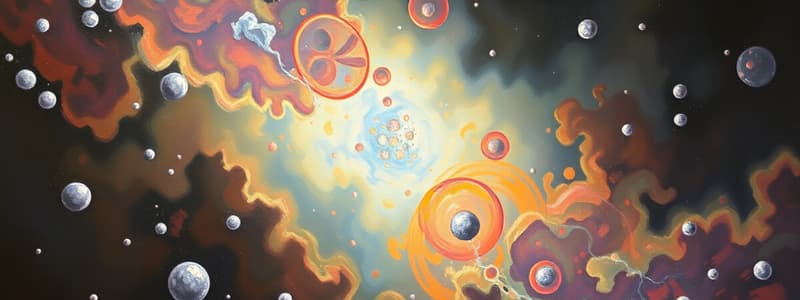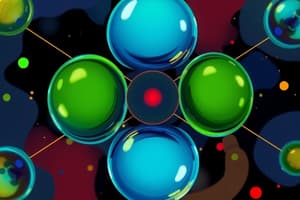Podcast
Questions and Answers
What is a characteristic of a homogeneous mixture?
What is a characteristic of a homogeneous mixture?
- It consists of indistinguishable components. (correct)
- It can be easily separated by physical means.
- It has visibly distinct parts.
- It has varying composition in different regions.
Which of the following examples is classified as a heterogeneous mixture?
Which of the following examples is classified as a heterogeneous mixture?
- Sand stirred into water (correct)
- Air
- Brass
- Table salt in water
Which property distinguishes heterogeneous mixtures from homogeneous mixtures?
Which property distinguishes heterogeneous mixtures from homogeneous mixtures?
- Contains regions with different properties. (correct)
- Consists of components that can be easily separated.
- Consists of visibly indistinguishable parts.
- Has a uniform composition throughout.
Which of the following is NOT considered a homogeneous mixture?
Which of the following is NOT considered a homogeneous mixture?
What term is also used to refer to a homogeneous mixture?
What term is also used to refer to a homogeneous mixture?
What unique characteristic defines a solid compared to liquids and gases?
What unique characteristic defines a solid compared to liquids and gases?
How does a liquid differ from a solid and a gas in terms of volume?
How does a liquid differ from a solid and a gas in terms of volume?
What happens to particles during the process of melting?
What happens to particles during the process of melting?
Why do gases fill the entire volume of their container?
Why do gases fill the entire volume of their container?
What occurs at the boiling point of a liquid?
What occurs at the boiling point of a liquid?
Which statement accurately describes the arrangement of particles in a solid?
Which statement accurately describes the arrangement of particles in a solid?
Which of the following materials is an example of a gas?
Which of the following materials is an example of a gas?
What best explains why solids maintain a definite shape and volume?
What best explains why solids maintain a definite shape and volume?
What defines a physical change in a substance?
What defines a physical change in a substance?
Which of the following describes a characteristic of a chemical property?
Which of the following describes a characteristic of a chemical property?
What distinguishes a compound from an element?
What distinguishes a compound from an element?
Which of the following is a sign of a chemical change?
Which of the following is a sign of a chemical change?
Which of the following combinations is NOT an example of a compound?
Which of the following combinations is NOT an example of a compound?
Which characteristic is true for both elements and compounds?
Which characteristic is true for both elements and compounds?
Which of the following processes is a physical change?
Which of the following processes is a physical change?
What is a property characteristic of pure substances?
What is a property characteristic of pure substances?
Which of the following statements is true regarding mixtures?
Which of the following statements is true regarding mixtures?
Which term describes the ability of a substance to undergo a specific chemical change?
Which term describes the ability of a substance to undergo a specific chemical change?
Which of the following is an incorrect identification of a chemical change?
Which of the following is an incorrect identification of a chemical change?
Which of the following is NOT an example of a physical property?
Which of the following is NOT an example of a physical property?
What happens to substance characteristics during a chemical change?
What happens to substance characteristics during a chemical change?
Which observation is typically associated with chemical reactions?
Which observation is typically associated with chemical reactions?
Flashcards are hidden until you start studying
Study Notes
Matter Overview
- Matter is defined as anything that occupies space and has mass.
- Three primary states of matter exist: solid, liquid, and gas.
Solid Characteristics
- Solids are rigid with a definite shape and volume.
- Examples include ice cubes, diamonds, and iron bars.
Liquid Characteristics
- Liquids have a definite volume but take the shape of their container.
- Common examples are gasoline, water, alcohol, and blood.
Gas Characteristics
- Gases have no fixed volume or shape, expanding to fill their container.
- Examples include air, helium, and oxygen.
Physical Properties
- Physical properties are directly observable characteristics unique to a substance.
- Examples include color, melting point, and boiling point.
Physical Changes
- Physical change refers to alterations in physical properties without changing chemical composition.
- Boiling water or freezing water exemplifies physical changes.
Chemical Properties
- Chemical properties indicate a substance's ability to form new substances.
- Examples include flammability, rust formation, and food digestion.
Chemical Changes
- Chemical changes involve the formation of new products.
- Indicators of a chemical reaction include light production, temperature changes, and gas evolution.
- Example: Methane reacting with oxygen in a Bunsen burner produces carbon dioxide and water.
Elements
- Elements are substances that cannot be decomposed into simpler substances through chemical means.
- Examples include iron (Fe), aluminum (Al), oxygen (O2), and hydrogen (H2).
Compounds
- Compounds consist of combinations of different elements that can be broken down by chemical methods.
- Examples include water (H2O), carbon dioxide (CO2), and table sugar (C12H22O11).
- Compounds maintain a consistent composition of atoms.
Pure Substances vs Mixtures
- Pure substances include both elements and compounds, characterized by a constant composition (e.g., pure water, gold).
- Mixtures have variable compositions and can comprise elements and/or compounds (e.g., wood, wine).
Homogeneous Mixtures
- Homogeneous mixtures, or solutions, have uniform composition throughout and consist of indistinguishable parts.
- Examples include air, brass, and saltwater.
Heterogeneous Mixtures
- Heterogeneous mixtures contain visibly distinguishable components with different properties.
- Examples include oil and vinegar dressing, and sand in water.
Separation of Mixtures
- Mixtures can be separated into their constituent pure substances through various methods.
Study Activity
- Engage in group discussions to differentiate particles in various states of matter through diagrams and concepts, such as particle spacing in solids vs. gases. Consider terms like melting and boiling points in relation to particle behavior.
Studying That Suits You
Use AI to generate personalized quizzes and flashcards to suit your learning preferences.




